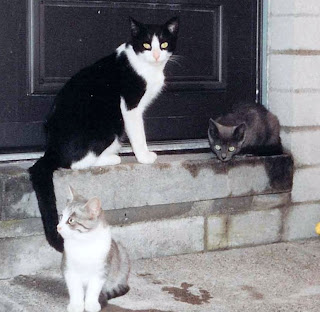We wanted to share an e-mail we received recently about
stray cat behavior written by someone who knows it well. The author, Jeremy, works at night and on his
walk home sees the cats most of us daytime people never know exist – the feral
and stray cats that hide from humans during the day and then come out in the
dark to look for food. Jeremy’s one of
the many unsung heroes of community cat care that -- after seeing these
homeless cats -- helps them the best way they can –by providing them with
supplemental food and human attention.
Here are his observations:
I recently found the article, “If You Find a Stray Cat” on your web site while Googling “how much to feed a starved cat.” It was a well-written piece with very sensible advice. I particularly liked the suggestion to collar a suspected stray with your contact information. It is a brilliant idea, and I had never thought of that. I have always been a cat lover and a sucker for strays. Over time, I have learned a few other tricks that your viewers might also find helpful.
There are SO MANY strays in my neighborhood. I walk home from work most nights, so I have begun carrying kibble and wet food in my backpack at all times. Although I’ve only lived here for a few months, most of my “regulars” have picked spots and know to meet me there for dinner. I also keep my camera with me, so I can try and find homes for these little ones.
In my experience, most strays do not immediately dart away when faced with eye contact. In fact, you can use eye contact to your advantage with a technique called the “slow blink”. It is a signal that cats use among each other that means, “We’re cool. We’re so not in a fight right now that I will even close my eyes while you are staring at me, and I will do it in my slow, lazy way.” This technique, coupled with soothing words and that “prbt” sound, has had dramatic results for me with startled or skittish cats. They will often run right up after the signal is given.
What will usually startle a stray are the headlights and noise of an oncoming car. I have had starving cats bolt away from a meal because of this, so I no longer put their dinner on the open sidewalk. If you can put their dinner behind a fence, wall, trash barrel, or under a parked car, they will feel much more comfortable.
As for recognizing a stray, well in the neighborhood, it is obvious. They are too thin. But the real tell is that once you establish trust, they will meow desperately and follow you for a block or two, sometimes even running ahead of you. A contented cat with a happy home does not do that.
We hope Jeremy's comments give you a window into the secret world of the night cats -- we just have one thing to add. Please don't remove the cats from their outdoor homes until and unless you have a plan that will ensure their future will be better than their present situation. On balance, outdoor cats do very well in their homes and removing them without a lifelong plan often puts their lives at risk.



